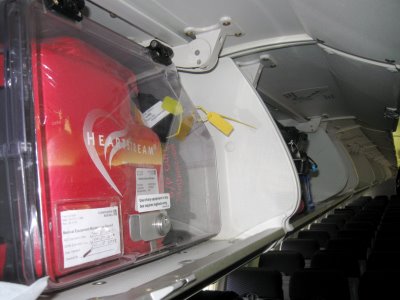 I have a myriad of responsibilities as a Flight Attendant and one of them is handling medical emergencies. Most people actually don’t know how much training goes into being a FA. Tonight I was reminded just how important my yearly recurrent training is when I had an on board medical emergency. Thankfully, our passenger was fine but I thought I would share some information with you that should make you more comfortable and secure knowing what resources are available to FA’s on the aircraft and what we are actually trained to do should an emergency arise.
I have a myriad of responsibilities as a Flight Attendant and one of them is handling medical emergencies. Most people actually don’t know how much training goes into being a FA. Tonight I was reminded just how important my yearly recurrent training is when I had an on board medical emergency. Thankfully, our passenger was fine but I thought I would share some information with you that should make you more comfortable and secure knowing what resources are available to FA’s on the aircraft and what we are actually trained to do should an emergency arise.
First Aid Equipment on board every aircraft:
- AED (Automatic External Defibrillator)
- Oxygen
- First Aid Kit
- Enhanced Medical Kit (to be used by medical personal)
- CPR masks
- Blood pressure cuff
- Universal precaution kit
What FA’s are trained to recognize symptoms of and treat:
- burns
- bleeding
- nausea
- allergic reaction (anaphylactic shock)
- cardiac arrest
- child birth
- choking
- seizures
- decompression illness
- diabetes
- eye injuries
- fainting
- food poisoning
- fractures and sprains
- heart attack
- heat exhaustion
- heat stroke
- hyperventilation
- hypothermia
- hypoxia
- shock
- stroke
Other resources on board:
- Med Link (med link is a hospital that our airline pays a yearly fee to) In the event of a medical emergency they are contacted and after presenting the patients symptoms to the Dr. on call, we follow his/her advice. Med link makes the decision on whether we will divert or continue on. If we have medical personal on the aircraft and they consult with med link, they are then covered by insurance, should anyone decide to sue them. ( FA’s are covered by the Good Samaritan Law)
- Most times we have medical personal on board as a resource. Doctors, nurses, E.M.Ts or paramedics are all great to have as passenger’s: )
- Our FA Inflight Manual has a chapter on first aid should we need to reference it.
I think another useful piece of information is what the A.E.D. actually does. A lot of people think it will re-start a stopped heart, it does not. The A.E.D. is a device that interprets heart rhythms and can deliver an electrical shock to the heart when needed.
There is also a difference between a Heart Attack and Cardiac Arrest:
Cardiac Arrest that is treatable by the A.E.D. is known as ventricular fibrillation it occurs when normal beating of the heart stops and the heart begins rapid, ineffective contractions which fail to pump blood through the body. Unless normal rhythm can be restored, the condition can be fatal…this is where the A.E.D. comes in. It restores the normal rhythm, it does not re-start a heart.
Heart Attack: Also known as myocardial infraction, a heart attack occurs when part of the heart muscle suddenly dies due to lack of blood flow, causing chest pain and decreased circulation. Here is where the relation to cardiac arrest comes in…a heart attack may ultimately lead to cardiac arrest and death.
One last piece of advice for those of you who have known medical issues:
- make sure your medications are in your small carry on….should the overheads fill up and you are forced to check your larger bag at the last minute and your meds are in that bag, you may forget to grab them in all the commotion.
- Please write down what your medical conditions are and list any meds you take and any food and drug allergies you have…even if you are traveling with someone else who knows this information because under stress and worry they are usually not too helpful with remembering information.
I hope this information is helpful, please let me know if there is anything else I can clarify on medical emergencies or our training in them, otherwise sit back, relax and enjoy your flight….your FA has your back 😉


 Facebook
Facebook Twitter
Twitter RSS
RSS Email
Email
Great info! I can’t wait until I start learning about all of this 🙂 Although I am pretty familiar with First Aid/CPR/AED from being a CNA 🙂
It is a good thing to know as a passanger! Do all aircraft have an AED now or just some of them?
My worst experience inside an airplane is just at the beginning of the flight I had a kidney stone attack. There was nothing to do other than drinking water and suffer the pain. It had been more than 30 years since the last one, but I recognized the pain instantly. I didn’t tell the FA because I assumed that nobody would give me the heavy duty pain killers that I needed and besides, I had to drive from the airport back home.
It wasn’t a fun flight, that’s for sure…
You forgot #23:
“Unruly Passengers”.
Using the AED to treat a UP (Unruly Passenger) is extremely effective. Place paddles in same position and……..
To be serious for a moment….
Leaving a film crew unsupervised is like having a 200 lb. chimp as a friend and a, well you get the meaning.
Set Decorators had dressed an ER set for this one show that you have all heard of with tons of goodies and one of the goodies was a real live Defib. machine. No one knew that it was live until someone plugged it in. One of the crew thought it would be a great gag to shock one of their buddies so……….
After the smoke cleared all Defib. machines are now gutted and inert.
I have always had the utmost respect for every member of the flight crew. Kudos to you and all your training.
Great post. Your blog is a fantastic mix of humour and information. Now if only you knew when not to use apostrophes. 🙂
Oh oh FP,
The Apostrophe Police are putting on their Jack boots.
this was a really great post.
i’m really loving your blog!
You guys use MedLink too? I’m nearly on a first name basis with them after the last few months 🙁
Thank You everyone for all the feedback, I appreciate it!
Question for you? my son has a cardiac condition and we have our own AED. We’d like to bring it on vacation. Are we permitted to carry it on the plane?
@Holly, I don’t see why you wouldn’t be able to. I tried to find an answer on TSA.gov, but didn’t have any luck. I would contact your airline ahead of time and ask them. Good Luck!
I guess this is a stale link, but you may want to update it a bit: On-board Medical folks, fly as PAX are also covered by the Good Sam laws. Otherwise, we would not respond to omst of your calls.
When I board a flight, I slip my susiness card, identifying me as a Medical Professional, to a FA – and I note my seat number on the back. I’ve bee called only a few times, bit it helps prevent that panicked PA call, “Help!! Is there a doctor or someone on board…” Good heavens, folks! I’m not seeking anything other than a safe flight. As a usually “J-Class” flyer, I’m perfectly happy with my environment and I do not need any extras. If I can help with a medical problem, I will and I know that I am protected. If I might offer a small correction: I have talked via cockpit radio with your Med-Link advisors a couple of times. They are good and talented folks. However, they to NOT, ever make the divert choices. That vital choice is ALWAYS the Captain’s responsibility. Smart Captains use ALL of their resources, company-based, external, like Med-Link and on-board. Captains are smart and t hey get it right. I’ve seen some ignore the ground advice and follow on-board ideas – and just as often, the reverse. When I assist with a flying medical event, my focus is ALWAYS the ill PAX. I use the kit that is offered to me and I communicate with the Captain when I have relevant information. Thereafter, I follow the Captain’s orders and prepare for whatever course s/he chooses.
With literally thousands of legs on my FF program, I’ve been asked to assist only a handfull of times. I guess we’ve been luckly, but I’ve never had a fellow PAX die while in my care.
I guess the major carriers just assume that their PAX mix will include somone with the odd skills. WHile I have recieved a couple of thank you notes from ill PAX, I’ve yet to recieve that courtest from an airline. It must be a legal thing – I guess.
In the end, being available has probably saved a couple of lives, (one for damn sure. I’m wuite happy with the notes from the grateful PAX and I do not want or need anything from the airlines. I don’t use alcohol when flying, so toss the drink coupons. I fly where and whn I wish, so I don’t need a ticket. Despite the airlines’ liability concerns – which are truly groundless, a very quiet ‘thank you,’ would be appreciated. I understand that and yes, I’m still available if called. Despite the corporate policy, I cannot *not* respond when asked to do so. -C.
[…] our training covers and what tools we have on board to handle medical emergencies read my post: “Everything you wanted to know about medical emergencies” Another funny thing is I’ve thought about starting a blog called, “People of Air […]
Truly instructive, looking forward to visiting again.